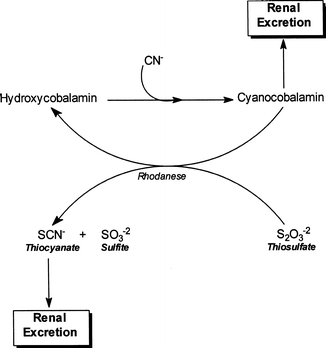
Strom-free methemoglobin is effective against four minimum lethal doses of cyanide in rats. This drives the reaction toward cyanomethemoglobin and liberates cyanide from cytochrome oxidase. The ferric iron in methemoglobin preferentially combines with cyanide, producing cyanomethemoglobin. Ĭyanide quickly and reversibly binds to the ferric iron in cytochrome oxidase, inhibiting effective energy production throughout the body. Nitrite-mediated antagonism of cyanide inhibition of cytochrome c oxidase in dopamine neurons. Leavesley HB, Li L, Mukhopadhyay S, Borowitz JL, Isom GE. In vivo antagonism of cyanide by NO(2)(-) appears to be due to both generation of mHb and direct displacement of cyanide from CcOX by NO. It was concluded that NaNO(2) antagonizes cyanide inhibition of CcOX by generating of NO, which then interacts directly with the binding of KCN x CcOX to reverse the toxicity.

The NaNO(2) antagonism of cyanide was blocked by pretreatment with the NO scavenger PTIO. Pretreatment with NaNO(2) reversed KCN-mediated inhibition of both oxygen consumption and CcOX activity. Under similar conditions, KCN (20muM) inhibited cellular state-3 oxygen consumption and CcOX activity. PTIO reversed the NO-mediated inhibition, thus providing strong evidence that NO mediates the action of NaNO(2).

NO generated from NaNO(2) decreased cellular oxygen consumption and inhibited CcOX activity. The NO scavenger 2-phenyl-4,4,5,5-tetramethylimidazoline-1-oxy 3-oxide (PTIO) reversed this increase in cellular and mitochondrial NO. NaNO(2) produced a time- and concentration-dependent increase in whole-cell and mitochondrial levels of NO. In this study, nitrite-mediated antagonism of cyanide inhibition of oxidative phosphorylation was examined in rat dopaminergic N27 cells. On the other hand, NO(2)(-) can undergo biotransformation to generate nitric oxide (NO), which may then directly antagonize cyanide inhibition of CcOX. mHb generation is thought to be a primary mechanism by which the NO(2)(-) ion antagonizes cyanide. Amyl nitrite and sodium nitrite (NaNO(2)) antagonize cyanide toxicity in part by oxidizing hemoglobin to methemoglobin (mHb), which then scavenges cyanide. Summary StructureĬyanide inhibits aerobic metabolism by binding to the binuclear heme center of cytochrome c oxidase (CcOX). Evidence-based medicine for Chemical Defense - including efficacy and safety A.

Chemical Defense therapeutic area(s) - including key possible usesĪmyl nitrite is typically used with other agents (sodium nitrite and sodium thiosulfate) as an antidote for acute cyanide poisoning. Name of Chemical Defense therapeutic agent/deviceĪmyl nitrite 2.


 0 kommentar(er)
0 kommentar(er)
